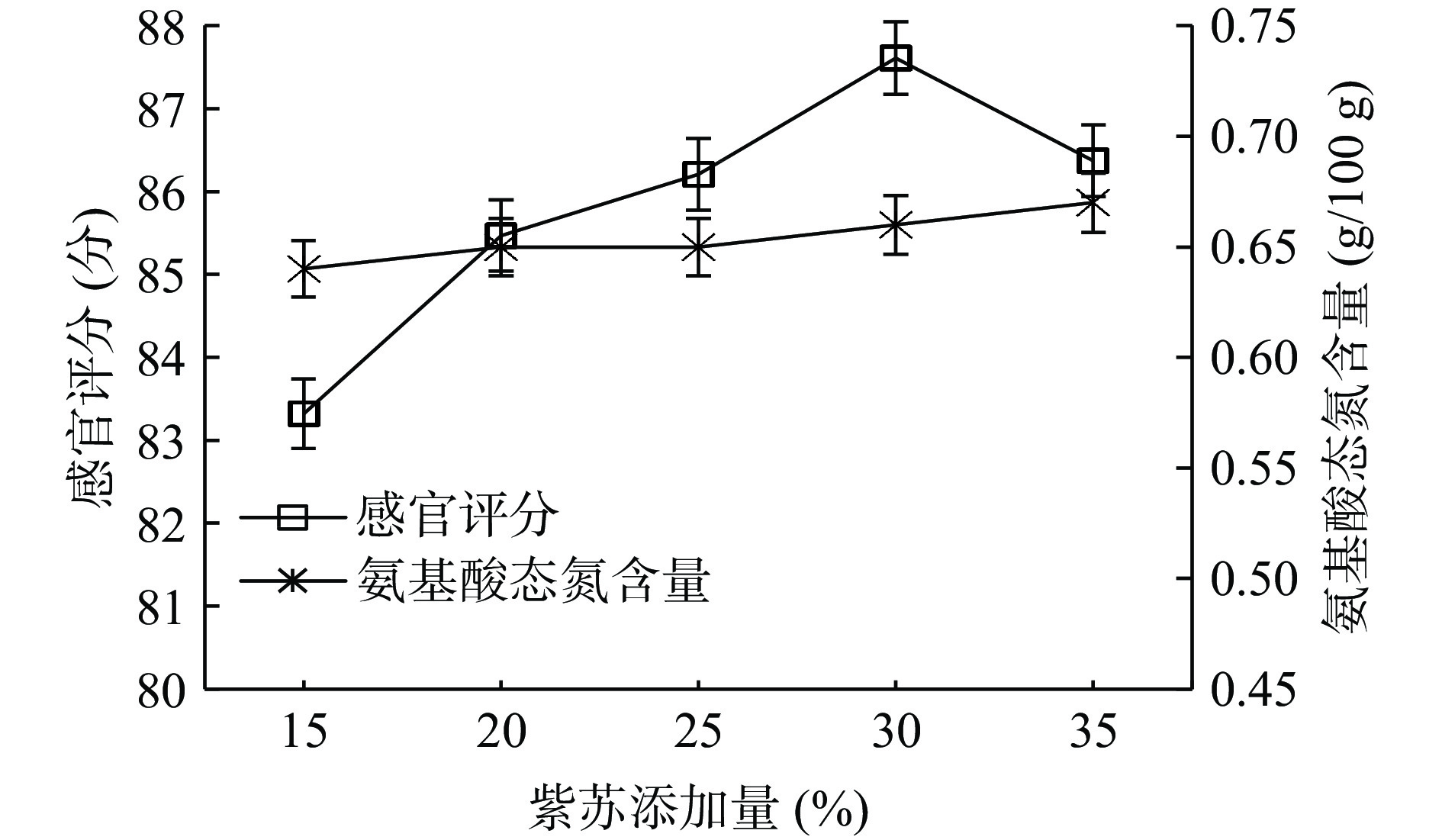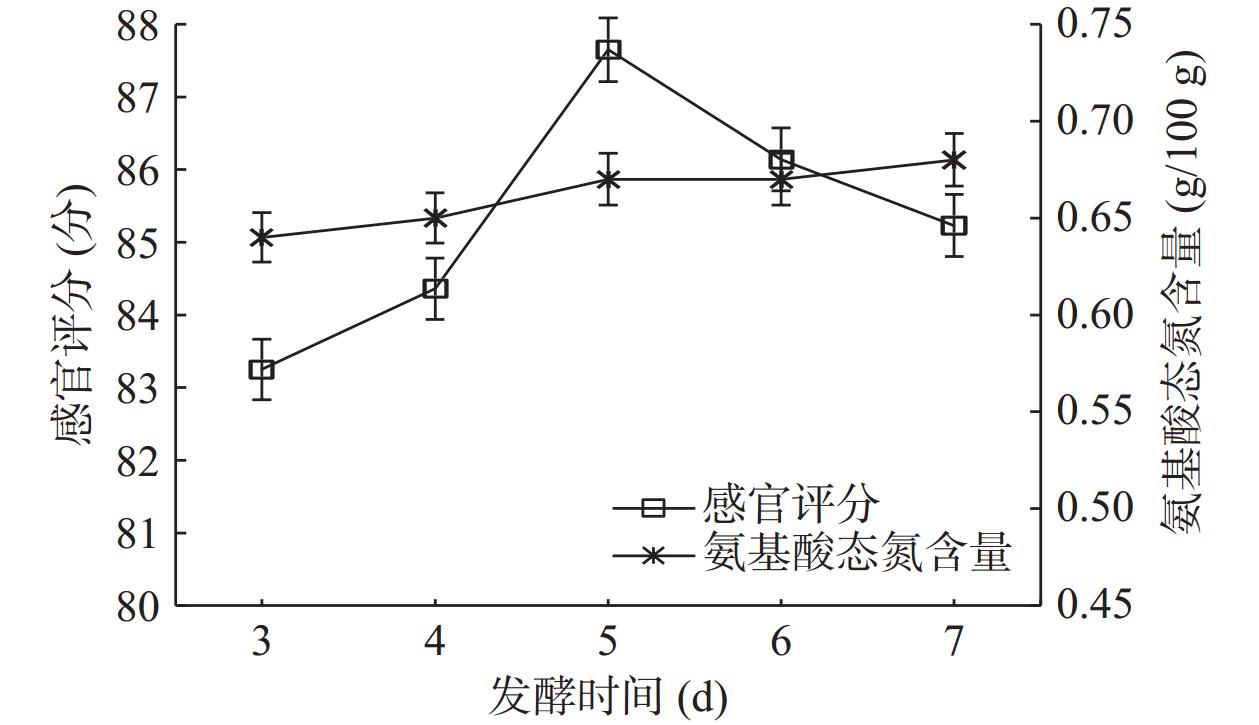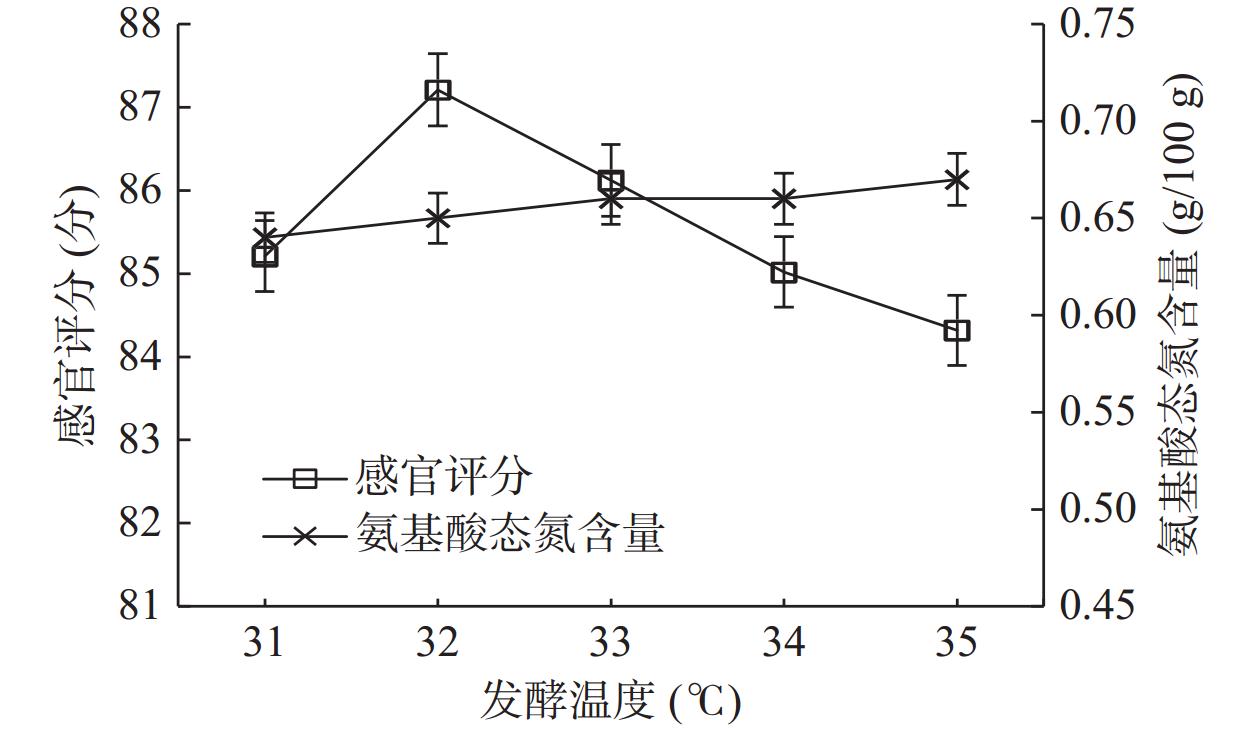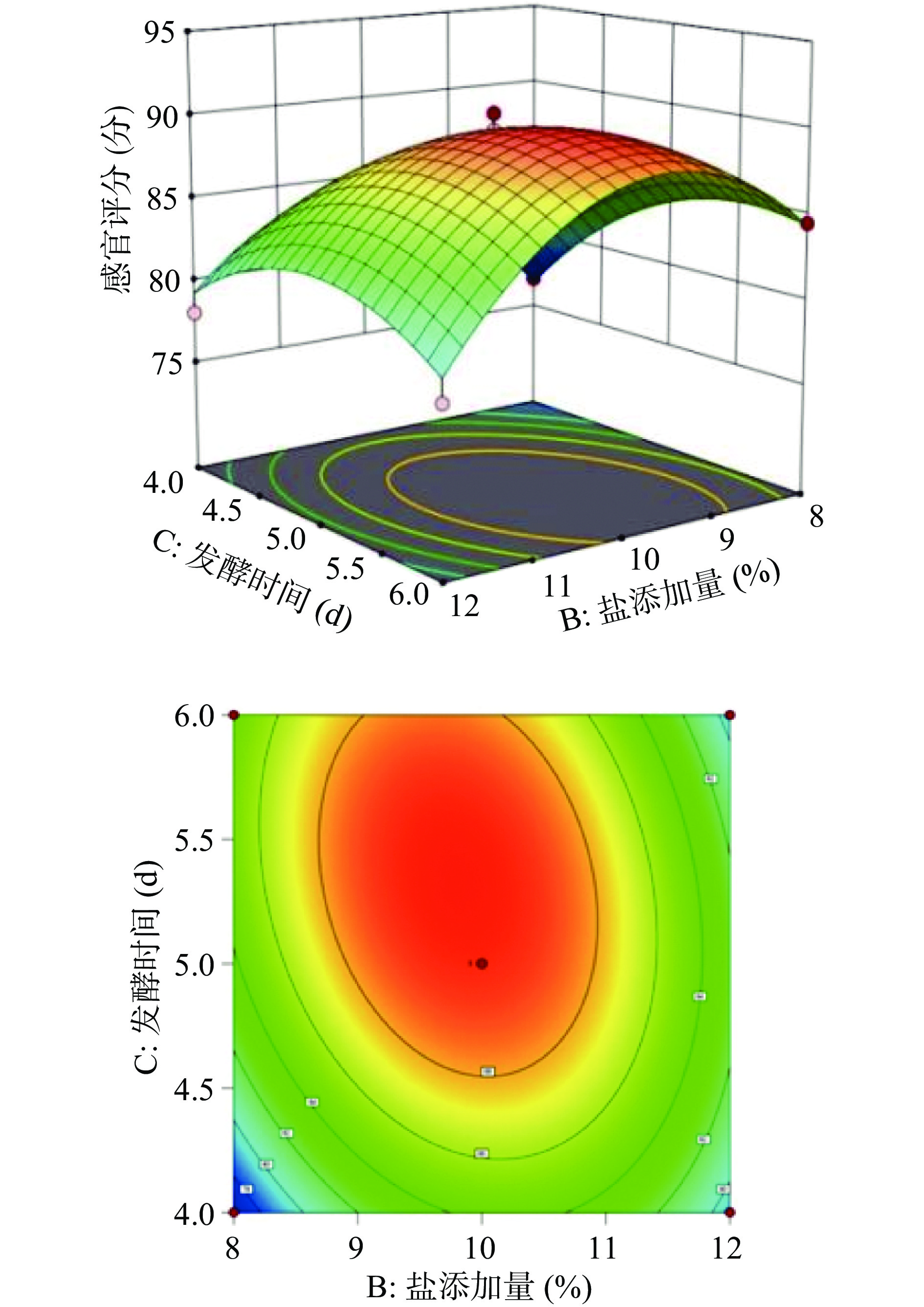Optimization of Low Salt Perilla Shrimp Paste and Analysis of Its Volatile Flavor Compounds
-
摘要: 本研究以东方白虾和紫苏为原料,通过传统制备结合添加曲种协同发酵的方法制备了低盐紫苏虾酱,研究了紫苏添加量、盐添加量、发酵时间和曲种接种量对低盐紫苏虾酱配方的影响。利用Box-Behnken得到的最佳工艺预测方案并基于实际生产条件对预测工艺条件进行修正,结果表明,加曲协同发酵能有效降低盐的添加量,即固定虾的添加量300 g,当紫苏添加量35%、盐添加量10%、曲种接种量3.5%,在32 ℃发酵时间5 d条件下,制备的低盐紫苏虾酱感官评分达到87.94;挥发性风味物质相对含量占97.82%,其中酯类6种,醇类11种,酸类9种,醛类5种;氨基酸态氮、盐分、蛋白质、水分和灰分等含量均达到SC/T 3602-2016行业标准要求,其中盐分含量为106 mg/100 g,低于GB/T 23789-2009国家标准中对于盐分含量不高于120 mg/100 g的要求,与市场上的产品相比具有低盐、高蛋白的特点。本研究的配方产品属于低盐食品,既保留了虾酱鲜醇适口的特点,又揉入了微辛淡甜的紫苏芳香。Abstract: This study developed a low-salt Perilla shrimp paste by combining traditional preparation with the addition of yeast strain co-fermentation using oriental white shrimp and Perilla as raw materials. The effects of Perilla addition, salt addition, fermentation time and inoculation amount of koji seeds on the formula of low-salt Perilla shrimp paste were studied utilize the optimal process prediction obtained from Box-Behnken and make adjustments to the predicted process conditions based on actual production conditions. The results showed that the co-fermentation with yeast could effectively reduce the amount of salt added. The results indicated that the amount of shrimp added was fixed at 300 g. The sensory evaluation of the low-salt Perilla shrimp paste prepared under the conditions of 35% Perilla addition, 10% salt addition, and 3.5% yeast inoculation was 87.94 under the conditions of fermentation time of 5 d at 32 ℃. Its relative content of volatile flavor substances reached 97.82%, including 6 esters, 11 alcohols, 9 acids and 5 aldehydes. The contents of amino acid nitrogen, salt, protein, moisture and ash all met the requirements of SC/T 3602-2016 industry standard. Among them, the salt content was 106 mg/100 g, which was lower than the requirement of GB/T 23789-2009 national standard for salt content not higher than 120 mg/100 g. Compared to products in the market, it featured low salt and high protein content. The formulated products in this study are low-salt foods. It combines the freshness and flavor of shrimp paste with the slightly pungent and sweet aroma of Perilla.
-
Keywords:
- Perilla shrimp paste /
- low-salt food /
- condiment /
- technology optimization /
- flavor analysis
-
虾酱是由虾类与食盐混合、发酵制成的膏状或者糊状食品[1−2]。作为沿海地区的传统调味品,虾酱风味鲜美、组织细腻、营养丰富,但其盐含量在25%~33%之间,对于需要限制食盐摄入量的人群如肾病、高血压、糖尿病等人群不友好,加上传统自然发酵制备时间长且不容易连续控制,以及产品腥味和杂味较重等问题,也给虾酱的工业生产和扩大应用带来瓶颈[3−5]。因而,作为虾酱第一生产大国,改进配方和工艺手段、嵌入现代食品加工手段是虾酱制备和产业发展的方向[6−7]。
紫苏在我国被广泛种植,其嫩叶具有特殊的芳香气味和特有的活性物质,可以解表散寒、行气和胃,在烹饪中多鲜食或作为调味辅料使用,近年深受餐饮消费市场的欢迎,常用于菜肴烹制与风味调味酱开发[8−11]。东方白虾是长臂虾科、白虾属,体形和额角与脊尾白虾相似,腹部各节背面圆滑无纵脊,相比于小白虾、眼子虾、蚝子虾、糠虾等,具有壳薄、肉嫩、味鲜等特点,并具有良好的加工特性,在中国东南各省尤其浙江省比较常见。同时,浙江沿海地区制备的虾酱制品,其形态粘稠、酱汁细腻、口味鲜香,但酱体浓咸,发酵周期较长,质量不稳定,且高盐虾酱不符合大健康背景下的消费潮流[12−13]。采用加曲协同发酵方式制备低盐虾酱,可以有效地降低盐的使用量,有效地减少腐败微生物的生长,解决低盐发酵周期长、产品质量不稳定等问题,还能保留传统自然发酵的感官品质,对风味有一定的改善作用,保证成品的品质稳定与安全[14]。
基于以上研究基础,为了解决虾酱高盐、风味局限等问题,本研究拟以东方白虾和紫苏为原料,在传统虾酱制备工艺的基础上通过添加曲种协同发酵,并增加鲜紫苏作为配料,研究盐的添加量、发酵时间、发酵品质对产品的影响,并进一步分析其理化特性及挥发性风味物质含量,本研究拟开发一款低盐、新风味的紫苏虾酱,为高品质虾酱的研究和企业扩大生产提供理论依据。
1. 材料与方法
1.1 材料与仪器
东方白虾(E.orientis) 鲜活,单体重50±5 g,购于杭州市水产市场;鲜紫苏叶、麸皮、豆粕、盐 购于杭州市万寿亭农贸市场;米曲霉3.042 购于春仕生物科技(上海)有限公司,甲醛、氢氧化钠、乙醇、邻苯二甲酸氢钾等 均为国产分析纯。
380-600L/ H均质机 美国PHD科技有限公司;MJ-PB40E254D破壁料理机 美的集团股份有限公司;EX4202/E电子天平 西杰天平(北京)仪器有限公司;LRH-150生化培养箱 上海仪天科学仪器有限公司;EXS8000H光谱测量仪 佳普仪器有限公司;GCMS-QP2010 SE色谱质谱联用仪 睿奥检测设备(东莞)有限公司。
1.2 实验方法
1.2.1 发酵成曲种的制备
参考罗美艳 [15]的方法。将麸皮32 g、豆粕8 g、蒸馏水32 mL充分混匀放入锥形瓶中,高温灭菌25 min,冷却至室温26 ℃后接入米曲霉15%(w/w),在恒温培养箱中29 ℃培养72 h,每9 h摇瓶1次,孢子长出并由嫩黄色转变成黄绿色完成发酵成曲种的制备。
1.2.2 紫苏虾酱制备
参考李文亚等[16]的方法,稍作改动。将东方白虾用清水清洗,沥干水分,将新鲜紫苏叶清洗干净,共同放入破壁料理机中速搅打5 min后放入发酵罐,同时加入成曲搅拌均匀,按实验设计条件进行发酵。
1.2.3 单因素实验
在预实验的基础上确定虾300 g添加量为固定值,以所有原料总和为基础,固定盐添加量为6%、成曲添加量为2%、发酵温度31 ℃、发酵时间3 d,考察紫苏添加量为所有原料总和的比例的15%、20%、25%、30%、35%对发酵虾酱的影响;盐添加量为所有原料总和的比例的6%、8%、10%、12%、14%时,设置紫苏添加量为所有原料总和的比例的15%、成曲添加量为所有原料总和的比例的2%、发酵温度31 ℃、发酵时间3 d;发酵时间为3、4、5、6、7 d时,设置紫苏添加量为所有原料总和的比例的15%、成曲添加量为所有原料总和的比例的2%、发酵温度31 ℃;发酵温度为31、32、33、34、35 ℃时,设置盐添加量为所有原料总和的比例的6%、成曲添加量为所有原料总和的比例的2%、发酵时间3 d;曲种接种量为2%、2.5%、3%、3.5%、4.5%时,设置盐添加量为所有原料总和的比例的6%、紫苏添加量为所有原料总和的比例的15%、发酵温度31 ℃、发酵时间3 d。以感官评分和氨基酸态氮含量为指标进行单因素实验。
1.2.4 响应面试验设计
根据单因素实验结果,确定虾添加量为300 g、发酵温度为32 ℃,选取紫苏添加量(A)、盐添加量(B)、发酵时间(C)和曲种接种量(D)等四个因素为自变量,以感官评分(Y)作为响应值,通过Desig-Expert13中的Box-Behnken对工艺条件进行优化,具体见表1。
表 1 响应面试验因素水平Table 1. Factors and levels of response surface test水平 A
紫苏添加量(%)B
盐添加量(%)C
发酵时间(d)D
曲种接种量(%)−1 25 8 4 3 0 30 10 5 3.5 1 35 12 6 4 1.2.5 感官评价
参考赵陆恺等[17]方法。通过对成品的感官属性分析,以现有成品作为对照,确定感官评价标准。选取12名具有食辣习惯的感官评价员,男女各半,年龄在20~25岁间,在感官评价前针对低盐紫苏虾酱辣的感官属性进行培训。将样品放入器皿,45 ℃水浴加热5 min,取样评分,每个样品评价3次,取平均值,具体标准见表2。
表 2 感官评定标准Table 2. Sensory evaluation criteria描述 优秀(16~20分) 良好(11~15分) 一般(6~10分) 较差(0~5分) 色泽(20%) 色泽均匀,红亮自然 色泽均匀,褐亮自然,少许杂色 色泽不均匀,褐亮,杂色较多 色泽暗淡,杂色较多 气味(20%) 无腥异味,紫苏味正常 少许腥味,紫苏味正常 少许腥味,紫苏味过浓或淡 腥异味较重,紫苏味过浓或淡 滋味(20%) 咸鲜感适宜,滋味适口 咸鲜感一般,滋味一般 咸鲜感过重或淡,滋味一般 咸鲜感过重或淡,滋味较差 组织状态(20%) 稠稀度适中,分散性优 稠稀度适中,分散性良 较稠或较稀,分散性一般 过稠或过稀,分散性较差 可接受度(20%) 非常乐于接受 乐于接受 可以接受 不可以接受 1.2.6 其他理化指标测定
氨基酸态氮含量的测定参考GB 5009.235-2016[18];挥发性风味物质参考赵洪雷等[19]的方法,采用顶空固相微萃取法结合气质联用仪进行测定,即虾酱样品中的挥发性物质的定性分析主要通过Nist 11 谱库检索及结合相关资料进行分析,以确定其化学组成即定性分析。采用峰面积归一化法进行虾酱样品的定量分析。盐分、蛋白质、水分和灰分等含量测定按照SC/T 3602-2016进行测定[20]。
1.3 数据处理
本试验重复3次,通过Excel2010和Desig-Expert13中的Box-Behnken进行数据统计与分析[21]。
2. 结果与分析
2.1 单因素实验
2.1.1 紫苏添加量对氨基酸态氮含量和感官评分的影响
紫苏添加量对虾酱样品氨基态氮含量和感官评分的影响如图1所示。
通过图1分析,发现紫苏添加量对低盐紫苏虾酱的感官评分有较大的影响,随着紫苏的添加量增加,感官评分呈先上升后下降趋势,低盐紫苏虾酱中紫苏的会增加紫苏风味,丰富味觉感受,但是添加量过多,紫苏特有的风味会影响虾酱本身的鲜醇味道感受,影响整体感官感受。紫苏添加量的改变对氨基酸态氮含量影响不明显。综合分析,低盐紫苏虾酱中紫苏的添加量为25%~35%时,风味较佳。
2.1.2 盐添加量对氨基态氮含量和感官评分的影响
盐加量对虾酱样品氨基态氮含量和感官评分的影响如图2所示。
传统虾酱的发酵是一个复杂的多菌群体系作用过程,微生物体系涵盖了有益微生物菌株与杂菌[22]。盐的添加量直接影响微生物生长和酶的活性,影响成品虾酱的理化特性、风味物质形成和食用安全性[17]。图2结果表明,随着盐的添加量增加,感官评分呈现先上升后下降的趋势,氨基酸态氮呈现缓慢增加的变化趋势,主要是在加曲协同发酵的基础上,盐的增加可以一定程度抑制杂菌的产生,利于氨基态氮和风味物质的形成,但是随着添加量增加,盐会抑制发酵微生物的活性,影响发酵效果。综上,紫苏虾酱中盐的添加量为8%~12%时,其氨基态氮含量和感官评分处于一个较优的水平。
2.1.3 发酵时间对氨基态氮含量和感官评分的影响
发酵时间对虾酱样品氨基态氮含量和感官评分的影响如图3所示。
发酵初期,蛋白质在酶和微生物的作用下,开始分解,氨基酸态氮含量增加,随着蛋白质被完全分解,氨基态氮含量不再增加[23]。由图3可知,随着发酵时间延长,感官评分呈现先上升后下降趋势,当发酵5 d时达到最高值,后开始下降,主要是受有机酸等代谢产物的影响,说明5 d时低盐紫苏虾酱发酵所获得的产品具有良好的综合感官评分,此时氨基酸态氮含量随着发酵时间延长而增加,其含量均≥0.60 g/100 g,符合SC/T 3602-2016行业标准要求。综合分析低盐紫苏虾酱适宜发酵时间为4~6 d。
2.1.4 发酵温度对氨基态氮含量和感官评分的影响
发酵温度对虾酱样品氨基态氮含量和感官评分的影响如图4所示。
温度对发酵的影响体现在影响产物生成速率和产率,温度越高,酶反应速度越快,微生物细胞生长代谢加快,产物提前生成。本研究中,适宜的温度可以加速酶对虾体内的蛋白质和脂肪等成分的诱导作用[24]。同时,发酵温度改变发酵液的物理性质而间接影响发酵,改变培养液的物理性质会影响到微生物细胞的生长。温度也能影响菌落总数的形成,影响发酵效果[25]。通过分析图4可知,当发酵温度为32 ℃时,感官评分最高,氨基酸态氮含量达到SC/T 3602-2016 虾酱行业标准的要求,低盐紫苏虾酱最适宜的发酵温度为32 ℃。
2.1.5 曲种接种量对氨基态氮含量和感官评分的影响
由于盐的添加量低于传统虾酱制备的添加量,对代谢产物的抑制作用下降,会降低成品风味品质[26]。曲种接种量直接影响发酵效果,适宜的曲种接种量能有效的调节发酵过程中微生物菌群的生长,减少酵母味、酒精味等异味的产生[27]。由图5可知,随着曲种接种量的增加,氨基酸态氮呈上升趋势,感官评分呈先上升,但在添加量为3.5%时出现拐点,后期感官评分有一定下降。当接种量为3.5%时,感官评分达到最高值,氨基酸态氮含量达到SC/T 3602-2016 虾酱行业标准的要求。主要是因为随着接种量增加,低盐紫苏虾酱发酵程度增加,当接种量为3.5%时其发酵效果最佳,接种量过多,其代谢产物会产生酵母味、酒精味等异味,因此选择接种量为3%~4%进行低盐紫苏虾酱响应面优化。
2.2 低盐紫苏虾酱制备工艺的响应面法优化
2.2.1 响应面设计与结果
在单因素实验的基础上,进一步优化低盐紫苏虾酱的工艺,选取紫苏添加量、盐添加量、发酵时间和曲种接种量等4个因素为研究对象,通过Design-Expert13中的Box-Behnken对工艺条件进行优化,具体设计方案和结果见表3。
表 3 响应面试验设计与结果Table 3. Response surface design and results试验号 因素 Y
感官评分(分)A紫苏
添加量B盐
添加量C发酵
时间D曲种
接种量1 −1 −1 0 0 80.4 2 1 −1 0 0 81.1 3 −1 1 0 0 81.4 4 1 1 0 0 80.2 5 0 0 −1 −1 78.5 6 0 0 1 −1 85.5 7 0 0 −1 1 83.5 8 0 0 1 1 83.7 9 −1 0 0 −1 81.6 10 1 0 0 −1 81.6 11 −1 0 0 1 83.6 12 1 0 0 1 84.1 13 0 −1 −1 0 76.8 14 0 1 −1 0 78 15 0 −1 1 0 84.5 16 0 1 1 0 78 17 −1 0 −1 0 81.7 18 1 0 −1 0 81.7 19 −1 0 1 0 87.3 20 1 0 1 0 85.1 21 0 −1 0 −1 80 22 0 1 0 −1 78.2 23 0 −1 0 1 80.5 24 0 1 0 1 80.5 25 0 0 0 0 88.2 26 0 0 0 0 90.5 27 0 0 0 0 90.5 28 0 0 0 0 89.5 29 0 0 0 0 89.2 2.2.2 回归模型的建立与方差分析
通过对表3响应面试验结果进行二次多元回归分析,获得低盐紫苏虾酱的感官评分对选取因素自变量的二次多项回归方程为: Y=−801.87+12.37A+37.57B+62.72C+114.82D−0.048AB−0.11AC+0.05AD−0.96BC+0.45BD−3.4−0.11A2−1.6B2−3.32C2−14.76D2。该模型的方差分析结果见表4。
表 4 回归模型方差分析Table 4. Analysis of variance of regression model来源 平方和 自由度df 均方 F值 P 显著性 模型 422.40 14 30.17 33.11 <0.0001 ** A 0.4033 1 0.4033 0.4427 0.5166 B 4.08 1 4.08 4.48 0.04 * C 47.60 1 47.60 52.25 <0.0001 ** D 9.19 1 9.19 10.08 0.0067 ** AB 0.9025 1 0.9025 0.9906 0.3365 AC 1.21 1 1.21 1.33 0.2685 AD 0.0625 1 0.0625 0.0686 0.7972 BC 14.82 1 14.82 16.27 0.0012 ** BD 0.8100 1 0.8100 0.8890 0.3617 CD 11.56 1 11.56 12.69 0.0031 ** A² 44.78 1 44.78 49.15 <0.0001 ** B² 265.89 1 265.89 291.84 <0.0001 ** C² 71.28 1 71.28 78.24 <0.0001 ** D² 88.32 1 88.32 96.94 <0.0001 ** 残差 12.76 14 0.9111 失拟项 9.01 10 0.9007 0.9613 0.5664 纯误差 3.75 4 0.9370 总和 435.15 28 注:“*”表示影响显著(P<0.05),“**”表示影响极显著(P<0.01)。 通过表4分析,方程的相关系数大于0.9,模型差异极显著(P<0.01),模型失拟项值差异不显著(P>0.05),说明模型拟合程度好。通过分析可知:B对结果影响显著(P<0.05),C、D对结果影响极显著(P<0.01);在二次项中,A²、B²、C²和D²对感官评分结果影响极显著(P<0.01);BC和CD交互作用对结果影响极显著(P<0.01)。各因素贡献率为C>D>B>A,即发酵时间>曲种添加量>盐添加量>紫苏添加量。
2.2.3 响应面交互作用分析
通过响应面图和等高线图,分析各因素之间的交互作用对低盐紫苏虾酱感官评分的影响。通过图6和图7发现,曲面图中曲线陡峭程度较大,等高线均趋于椭圆,说明盐添加量和发酵时间与发酵时间和曲种接种量这两组因素对感官评分的影响较大,两个因素交互作用极显著。
2.2.4 最佳工艺条件优化与验证
利用Box-Behnken得到的最佳工艺预测方案为:紫苏添加量34.82%、盐添加量9.78%、发酵时间5.23 d、曲种接种量3.54%,预测感官评分值为87.23。为了进一步的验证结果与实际是否一致,基于实际生产条件对预测工艺条件进行修正,修正后工艺方案为:紫苏添加量35%、盐添加量10%、发酵时间5 d、曲种接种量3.5%。按修正后工艺方案经过3次平行试验,感官评分优化后为值为87.94,与模型预测值相对误差为0.008,说明该模型较好的预测了低盐紫苏虾酱的制备工艺,可以用于实际生产。
2.3 虾酱挥发性风味物质分析
采用运行时间为30 min、不分流模式进样后获得的挥发性风味物质的种类和相对含量如表5所示。
表 5 挥发性风味物质的种类及相对含量Table 5. Types and relative contents of volatile flavor substances序号 分类 风味成分 相对含量(%) 1 酯类(6种) 5-羟基-十一酸内酯 1.01 2 水杨酸甲酯 8.01 3 异戊酸丁酯 3.31 4 硬脂酸乙酯 0.51 5 油酸乙酯 0.11 6 亚油酸乙酯 0.8 7 醇类(11种) 反式-2-己烯-1醇 16.30 8 环已醇 2.01 9 正己醇 6.32 10 1,2-环氧十八烷 7.3 11 棕櫚醇 0.63 12 芳樟醇 5.48 13 异辛醇 1.45 14 顺-2-戊烯-1-醇 1.08 15 对羟基苯甲醇 0.88 16 β-苯乙醇 4.65 17 3-甲基-1-戊醇 0.61 18 酸类(9种) 壬酸 2.19 19 己酸 1.01 20 反式-2-己烯基己酸 0.51 21 辛酸 0.61 22 棕榈酸 0.31 23 羊脂酸 1.25 24 十四烷酸 1.15 25
26十八烷酸
10-十一烯酸1.23
0.327 醛类(5种) 己醛 4.25 28 壬醛 2.99 29 十二醛 4.31 30 十一醛 0.87 31 视黄醛 11.62 32 酮类(5种) 氧杂环十七烷-2-酮 0.36 33 2-环己基环己酮 2.01 34 二乙基甲酮 0.69 35 4-异丙基环己酮 0.21 36 5-甲基-2-己酮 0.16 37 烯类(2种) 1-辛烯 0.31 38 1-十八烷烯 0.21 39 其他(2种) 愈创木酚 0.84 40 4-乙基苯酚 0.28 合计 97.82 通过表5分析,低盐紫苏虾酱共检测出40种挥发性物质,相对含量为97.82%。分析发现,酯类6种,其中5-羟基-十一酸内酯具有奶油椰子水果香气,水杨酸甲酯有强烈的冬青油香气,异戊酸丁酯呈香蕉香气和蓝干酪香味,硬脂酸乙酯无色无臭物质,略呈蜡香,亚油酸乙酯香气特征是淡雅花香和果香。即酯类中的风味成分具有果香和奶香,直接影响低盐紫苏虾酱的整体风味,其相对含量为13.75%。醇类11种,醇类中的风味成分具有花果香,风味醇厚,其含量高达46.71%。酸类9种,酸类物质具有果香和奶酪的香气,可以提升低盐紫苏虾酱的风味特点,其含量为8.56%。醛类5种,醛类物质和酮类物质均具有水果和令人愉悦的香气,其含量为24.04%。酯类、醇类、酸类、醛类和酮类是低盐紫苏虾酱的主要香气物质[28−29]。
2.4 虾酱其他理化指标
本研究以广味幼滑虾酱的蛋白质和NaCl作为重点,比较本产品与市售产品的差异如表6。
表 6 虾酱的其他理化指标Table 6. Other physical and chemical indicators of shrimp paste指标 标准来源 标准指标 结果 氨基酸态氮(以N计),
(g/100 g)SC/T 3602-2016 ≥0.6 0.67 广味幼滑虾酱盐分
(以NaCl计)GB/T 23789-2009 ≤120 mg/
100 g107 mg/
100 g低盐紫苏虾酱盐分
(以NaCl计)GB/T 23789-2009 ≤120 mg/
100 g106 mg/
100 g广味幼滑虾酱蛋白质(%) SC/T 3602-2016 ≥10 16 低盐紫苏虾酱蛋白质(%) SC/T 3602-2016 ≥10 21 水分(%) SC/T 3602-2016 ≤60 35 灰分(%) SC/T 3602-2016 ≤35 27 对按最佳工艺条件制备的低盐紫苏虾酱进行部分理化指标分析,发现氨基酸态氮、盐分、蛋白质、水分和灰分含量均达到SC/T 3602-2016行业标准要求,与广味幼滑虾酱对比盐分和蛋白质指标,低盐紫苏虾酱均优于市售产品。其中盐分含量为106 mg/100 g,低于GB/T 23789-2009国家标准中对于盐分含量不高于120 mg/100 g的要求,按该工艺生产的紫苏虾酱属于低盐食品。
3. 结论
研究发现,加曲协同发酵能有效的减少盐的添加量,抑制杂菌的产生,利于氨基态氮和风味物质的形成,保证发酵效果;通过单因素实验和响应面分析法优化生产工艺,当虾添加量300 g、紫苏添加量35%、盐添加量10%、曲种接种量3.5%,在32 ℃的发酵温度条件下,发酵时间5 d制备的低盐紫苏虾酱品质最优;挥发性风味物质含量丰富,检测出的40种挥发性风味物质相对含量占97.82%;与市场上成品虾酱相对比,氨基酸态氮、盐分、蛋白质、水分和灰分等含量均达到SC/T 3602-2016行业标准要求,其中盐分含量低于GB/T 23789-2009国家标准,本产品含盐量为106 mg/100 g属于低盐食品。
-
表 1 响应面试验因素水平
Table 1 Factors and levels of response surface test
水平 A
紫苏添加量(%)B
盐添加量(%)C
发酵时间(d)D
曲种接种量(%)−1 25 8 4 3 0 30 10 5 3.5 1 35 12 6 4 表 2 感官评定标准
Table 2 Sensory evaluation criteria
描述 优秀(16~20分) 良好(11~15分) 一般(6~10分) 较差(0~5分) 色泽(20%) 色泽均匀,红亮自然 色泽均匀,褐亮自然,少许杂色 色泽不均匀,褐亮,杂色较多 色泽暗淡,杂色较多 气味(20%) 无腥异味,紫苏味正常 少许腥味,紫苏味正常 少许腥味,紫苏味过浓或淡 腥异味较重,紫苏味过浓或淡 滋味(20%) 咸鲜感适宜,滋味适口 咸鲜感一般,滋味一般 咸鲜感过重或淡,滋味一般 咸鲜感过重或淡,滋味较差 组织状态(20%) 稠稀度适中,分散性优 稠稀度适中,分散性良 较稠或较稀,分散性一般 过稠或过稀,分散性较差 可接受度(20%) 非常乐于接受 乐于接受 可以接受 不可以接受 表 3 响应面试验设计与结果
Table 3 Response surface design and results
试验号 因素 Y
感官评分(分)A紫苏
添加量B盐
添加量C发酵
时间D曲种
接种量1 −1 −1 0 0 80.4 2 1 −1 0 0 81.1 3 −1 1 0 0 81.4 4 1 1 0 0 80.2 5 0 0 −1 −1 78.5 6 0 0 1 −1 85.5 7 0 0 −1 1 83.5 8 0 0 1 1 83.7 9 −1 0 0 −1 81.6 10 1 0 0 −1 81.6 11 −1 0 0 1 83.6 12 1 0 0 1 84.1 13 0 −1 −1 0 76.8 14 0 1 −1 0 78 15 0 −1 1 0 84.5 16 0 1 1 0 78 17 −1 0 −1 0 81.7 18 1 0 −1 0 81.7 19 −1 0 1 0 87.3 20 1 0 1 0 85.1 21 0 −1 0 −1 80 22 0 1 0 −1 78.2 23 0 −1 0 1 80.5 24 0 1 0 1 80.5 25 0 0 0 0 88.2 26 0 0 0 0 90.5 27 0 0 0 0 90.5 28 0 0 0 0 89.5 29 0 0 0 0 89.2 表 4 回归模型方差分析
Table 4 Analysis of variance of regression model
来源 平方和 自由度df 均方 F值 P 显著性 模型 422.40 14 30.17 33.11 <0.0001 ** A 0.4033 1 0.4033 0.4427 0.5166 B 4.08 1 4.08 4.48 0.04 * C 47.60 1 47.60 52.25 <0.0001 ** D 9.19 1 9.19 10.08 0.0067 ** AB 0.9025 1 0.9025 0.9906 0.3365 AC 1.21 1 1.21 1.33 0.2685 AD 0.0625 1 0.0625 0.0686 0.7972 BC 14.82 1 14.82 16.27 0.0012 ** BD 0.8100 1 0.8100 0.8890 0.3617 CD 11.56 1 11.56 12.69 0.0031 ** A² 44.78 1 44.78 49.15 <0.0001 ** B² 265.89 1 265.89 291.84 <0.0001 ** C² 71.28 1 71.28 78.24 <0.0001 ** D² 88.32 1 88.32 96.94 <0.0001 ** 残差 12.76 14 0.9111 失拟项 9.01 10 0.9007 0.9613 0.5664 纯误差 3.75 4 0.9370 总和 435.15 28 注:“*”表示影响显著(P<0.05),“**”表示影响极显著(P<0.01)。 表 5 挥发性风味物质的种类及相对含量
Table 5 Types and relative contents of volatile flavor substances
序号 分类 风味成分 相对含量(%) 1 酯类(6种) 5-羟基-十一酸内酯 1.01 2 水杨酸甲酯 8.01 3 异戊酸丁酯 3.31 4 硬脂酸乙酯 0.51 5 油酸乙酯 0.11 6 亚油酸乙酯 0.8 7 醇类(11种) 反式-2-己烯-1醇 16.30 8 环已醇 2.01 9 正己醇 6.32 10 1,2-环氧十八烷 7.3 11 棕櫚醇 0.63 12 芳樟醇 5.48 13 异辛醇 1.45 14 顺-2-戊烯-1-醇 1.08 15 对羟基苯甲醇 0.88 16 β-苯乙醇 4.65 17 3-甲基-1-戊醇 0.61 18 酸类(9种) 壬酸 2.19 19 己酸 1.01 20 反式-2-己烯基己酸 0.51 21 辛酸 0.61 22 棕榈酸 0.31 23 羊脂酸 1.25 24 十四烷酸 1.15 25
26十八烷酸
10-十一烯酸1.23
0.327 醛类(5种) 己醛 4.25 28 壬醛 2.99 29 十二醛 4.31 30 十一醛 0.87 31 视黄醛 11.62 32 酮类(5种) 氧杂环十七烷-2-酮 0.36 33 2-环己基环己酮 2.01 34 二乙基甲酮 0.69 35 4-异丙基环己酮 0.21 36 5-甲基-2-己酮 0.16 37 烯类(2种) 1-辛烯 0.31 38 1-十八烷烯 0.21 39 其他(2种) 愈创木酚 0.84 40 4-乙基苯酚 0.28 合计 97.82 表 6 虾酱的其他理化指标
Table 6 Other physical and chemical indicators of shrimp paste
指标 标准来源 标准指标 结果 氨基酸态氮(以N计),
(g/100 g)SC/T 3602-2016 ≥0.6 0.67 广味幼滑虾酱盐分
(以NaCl计)GB/T 23789-2009 ≤120 mg/
100 g107 mg/
100 g低盐紫苏虾酱盐分
(以NaCl计)GB/T 23789-2009 ≤120 mg/
100 g106 mg/
100 g广味幼滑虾酱蛋白质(%) SC/T 3602-2016 ≥10 16 低盐紫苏虾酱蛋白质(%) SC/T 3602-2016 ≥10 21 水分(%) SC/T 3602-2016 ≤60 35 灰分(%) SC/T 3602-2016 ≤35 27 -
[1] 孙国勇, 左映平. 虾酱发酵技术及研究进展[J]. 中国调味品,2013,38(1):60−62. [SUN Guoyong, ZUO Yingping. Fermentation technology and research progress of shrimp paste[J]. China Condiment,2013,38(1):60−62.] SUN Guoyong, ZUO Yingping . Fermentation technology and research progress of shrimp paste[J]. China Condiment,2013 ,38 (1 ):60 −62 .[2] 吴帅, 杨锡洪, 解万翠, 等. 低值虾发酵制备传统虾酱风味的综合分析与比较[J]. 食品科学,2016,37(2):121−127. [WU Shuai, YANG Xihong, XIE Wancui, et al. Comprehensive analysis and comparison of the flavor of traditional fermented shrimp paste produced from trash shrimp[J]. Food Science,2016,37(2):121−127.] WU Shuai, YANG Xihong, XIE Wancui, et al . Comprehensive analysis and comparison of the flavor of traditional fermented shrimp paste produced from trash shrimp[J]. Food Science,2016 ,37 (2 ):121 −127 .[3] 谢主兰, 雷晓凌, 何晓丽, 等. 食盐添加量对低盐虾酱品质特征的影响[J]. 食品工业科技,2012,33(9):116−119. [XIE Zhulan, LEI Xiaoling, HE Xiaoli, et al. Effect of salt addition lever on the quality characteristics of low-salt shrimp sauce[J]. Science and Technology of Food Industry,2012,33(9):116−119.] XIE Zhulan, LEI Xiaoling, HE Xiaoli, et al . Effect of salt addition lever on the quality characteristics of low-salt shrimp sauce[J]. Science and Technology of Food Industry,2012 ,33 (9 ):116 −119 .[4] 江津津, 欧爱芬, 潘光健, 等. 不同产地传统海虾酱的风味特征[J]. 水产学报, 2021, 45(12):2072−2082. [JIANG Jinjin, OU Aifen, PAN Guangjian, et al. Flavor characteristics of traditional shrimp sauce from different producing areas [J] Journal of Fisheries of China, 2021, 45(12):2072−2082.] JIANG Jinjin, OU Aifen, PAN Guangjian, et al. Flavor characteristics of traditional shrimp sauce from different producing areas [J] Journal of Fisheries of China, 2021, 45(12): 2072−2082.
[5] 孟凡欣. 酶解法生产虾酱的工艺探究[J]. 食品安全导刊,2023(4):119−121. [MENG Fanxin. Study on the technology of producing shrimp paste by enzymatic hydrolysis[J]. China Food Safety,2023(4):119−121.] MENG Fanxin . Study on the technology of producing shrimp paste by enzymatic hydrolysis[J]. China Food Safety,2023 (4 ):119 −121 .[6] YU Jing, LU Kuan, ZI Jiwei, et al. Characterization of aroma profiles and aroma-active compounds in high-salt and low-salt shrimp paste by molecular sensory science[J]. Food Bioscience,2022,45:101470. doi: 10.1016/j.fbio.2021.101470
[7] 杨兵兵, 王利文, 陈智慧, 等. 发酵温度对低盐虾酱中主要风味物质的影响[J]. 食品科学,2023,44(20):300−308. [YANG Bingbing, WANG Liwen, CHEN Zhihui, et al. Effect of fermentation temperature on the main flavour substances in low-salt shrimp paste[J]. Food Science,2023,44(20):300−308.] YANG Bingbing, WANG Liwen, CHEN Zhihui, et al . Effect of fermentation temperature on the main flavour substances in low-salt shrimp paste[J]. Food Science,2023 ,44 (20 ):300 −308 .[8] 于二汝, 袁婷婷, 杨航, 等. 14份紫叶紫苏叶片营养综合评价及精油型分析[J]. 食品工业科技,2022,43(24):311−319. [YU Erru, YUAN Tingting, YANG Hang, et al. Comprehensive nutritional evaluation and essential oil type analysis of 14 purple Perilla frutescens lines[J]. Science and Technology of Food Industry,2022,43(24):311−319.] YU Erru, YUAN Tingting, YANG Hang, et al . Comprehensive nutritional evaluation and essential oil type analysis of 14 purple Perilla frutescens lines[J]. Science and Technology of Food Industry,2022 ,43 (24 ):311 −319 .[9] 孟祥忍, 许志诚, 王恒鹏, 等. 预淮扬菜工业化现状及发展路径[J]. 美食研究,2023,40(1):53−59. [MENG Xiangren, XU Zhicheng, WANG Hengpeng, et al. Industrialization status and development path of pre Huaiyang Cuisine[J]. Food Research,2023,40(1):53−59.] MENG Xiangren, XU Zhicheng, WANG Hengpeng, et al . Industrialization status and development path of pre Huaiyang Cuisine[J]. Food Research,2023 ,40 (1 ):53 −59 .[10] 张洁, 许志颖, 薄文文, 等. 后疫情时代复合调味料研发方向及风味研发系统开发的思考与建议[J]. 中国食品添加剂,2023,34(4):338−344. [ZHANG Jie, XU Zhiying, BO Wenwen, et al. Reflections and suggestions on the research and development direction of composite seasonings and flavor research and development systems in the post epidemic era[J]. China Food Additives,2023,34(4):338−344.] ZHANG Jie, XU Zhiying, BO Wenwen, et al . Reflections and suggestions on the research and development direction of composite seasonings and flavor research and development systems in the post epidemic era[J]. China Food Additives,2023 ,34 (4 ):338 −344 .[11] DELA ROSA C J O, LEE A C, RIVERA W L. Pink pigmented facultative methylotrophic bacteria isolated from fermented Philippine shrimp paste[J]. Tropical Life Sciences Research,2021,32(2):147−161. doi: 10.21315/tlsr2021.32.2.10
[12] 班雨函, 杨兵兵, 马爱进, 等. 不同香辛料对低盐虾酱中微生物群落和理化性质的影响[J]. 食品科学,2023,44(8):143−151. [BAN Yuhan, YANG Bingbing, MA Aijin, et al. Effects of different spices on microbial community and physicochemical properties of low salt shrimp paste[J]. Food Science,2023,44(8):143−151.] BAN Yuhan, YANG Bingbing, MA Aijin, et al . Effects of different spices on microbial community and physicochemical properties of low salt shrimp paste[J]. Food Science,2023 ,44 (8 ):143 −151 .[13] 林杨, 李雪, 楚敏, 等. 产 γ-氨基丁酸乳酸菌的发酵条件优化[J]. 食品研究与开发,2023,44(4):150−155,224. [LIN Yang, LI Xue, CHU Min, et al. γ- Optimization of fermentation conditions for aminobutyric acid lactic acid bacteria[J]. Food Research and Development,2023,44(4):150−155,224.] LIN Yang, LI Xue, CHU Min, et al . γ- Optimization of fermentation conditions for aminobutyric acid lactic acid bacteria[J]. Food Research and Development,2023 ,44 (4 ):150 −155,224 .[14] LUO Meiyan, LIU Huanming, XIANG Jiang, et al. Screening of flavor strains in shrimp sauce and analysis of their fermentation performance[J]. Journal of Guangdong Ocean University,2022,42(2):79−87.
[15] 罗美燕. 虾酱快速发酵工艺的优化及微生物多样性和风味分析研究[D]. 湛江:广东海洋大学, 2022. [LUO Meiyan. Optimization of rapid fermentation process for shrimp sauce and analysis of microbial diversity and flavor [D]. Zhanjiang:Guangdong Ocean University, 2022.] LUO Meiyan. Optimization of rapid fermentation process for shrimp sauce and analysis of microbial diversity and flavor [D]. Zhanjiang: Guangdong Ocean University, 2022.
[16] 李文亚, 刘洋, 李宁, 等. 蛋白酶制剂对虾酱发酵过程中理化性质和微生物区系的影响[J]. 食品科学,2021,42(10):184−192. [LI Wenya, LIU Yang, LI Ning, et al. Effects of protease preparation on physicochemical properties and microbial flora in the fermentation of shrimp paste[J]. Food Science,2021,42(10):184−192.] LI Wenya, LIU Yang, LI Ning, et al . Effects of protease preparation on physicochemical properties and microbial flora in the fermentation of shrimp paste[J]. Food Science,2021 ,42 (10 ):184 −192 .[17] 赵陆恺, 胥亚夫, 丁威, 等. 灭菌方式对南极大磷虾酱料品质的影响[J]. 中国食品学报,2022,22(10):221−231. [ZHAO Lukai, XU Yafu, DING Wei, et al. The effect of sterilization methods on the quality of Antarctic krill sauce[J]. Chinese Journal of Food Science,2022,22(10):221−231.] ZHAO Lukai, XU Yafu, DING Wei, et al . The effect of sterilization methods on the quality of Antarctic krill sauce[J]. Chinese Journal of Food Science,2022 ,22 (10 ):221 −231 .[18] 中华人民共和国卫生和计划生育委员会. 食品安全国家标准 食品中氨基酸态氮的测定GB 5009.235-2016 [S]. 北京:中国标准出版社, 2016:5−8. [Health and Family Planning Commission of the People's Republic of China. National food safety standard Determination of amino acid nitrogen in food GB 5009.235-2016 [S]. Beijing:China Standards Publishing House, 2016:5−8.] Health and Family Planning Commission of the People's Republic of China. National food safety standard Determination of amino acid nitrogen in food GB 5009.235-2016 [S]. Beijing: China Standards Publishing House, 2016: 5−8.
[19] 赵洪雷, 尹一鸣, 陈义莹, 等. 不同产地虾酱风味特征及差异分析[J]. 食品与发酵工业,2019,45(10):194−200. [ZHAO Honglei, YIN Yiming, CHEN Yiying, et al. Analysis of flavor characteristics and differences in shrimp sauce from different regions[J]. Food and Fermentation Industry,2019,45(10):194−200.] ZHAO Honglei, YIN Yiming, CHEN Yiying, et al . Analysis of flavor characteristics and differences in shrimp sauce from different regions[J]. Food and Fermentation Industry,2019 ,45 (10 ):194 −200 .[20] 中华人民共和国农业部. 水产行业标准 虾酱SC/T 3602-2016 [S]. 北京:中国标准出版社, 2016:1−3. [Ministry of Agriculture of the People's Republic of China. Aquatic industry standard shrimp sauce SC/T 3602-2016[S]. Beijing:China Standards Publishing House, 2016:1−3.] Ministry of Agriculture of the People's Republic of China. Aquatic industry standard shrimp sauce SC/T 3602-2016[S]. Beijing: China Standards Publishing House, 2016: 1−3.
[21] 贺祺涵, 赵江林, 廖青夏, 等. 黑米荞麦米酒发酵工艺[J]. 食品研究与开发,2023,44(6):78−85. [HE Qihan, ZHAO Jianglin, LIAO Qingxia, et al. Fermentation process of black rice buckwheat rice wine[J]. Food Research and Development,2023,44(6):78−85.] HE Qihan, ZHAO Jianglin, LIAO Qingxia, et al . Fermentation process of black rice buckwheat rice wine[J]. Food Research and Development,2023 ,44 (6 ):78 −85 .[22] IWAMOTO A, HAMAJIMA H, TSUGE K, et al. Inhibitory effects of green Asparagus extract, especially phospholipids, on allergic responses in vitro and in vivo[J]. Journal of Agricultural and Food Chemistry,2020,68(51):15199−15207. doi: 10.1021/acs.jafc.0c05615
[23] SHEN P, GAO Z, XU M, et al. Physicochemical and structural properties of proteins extracted from dehulled industri al hempseeds:Role of defatting process and precipitation pH[J]. Food Hydrocolloids,2020,108:106065. doi: 10.1016/j.foodhyd.2020.106065
[24] YANG L, JIA J, ZHOU X, et al. Phosvitin-wheat gluten complex catalyzed by transglutaminase in the presence of Na2SO3:Formation, crosslink behavior and emulsifying properties[J]. Food Chemistry,2021,346:128903. doi: 10.1016/j.foodchem.2020.128903
[25] 陈蓬凤, 邹浩峰, 蔡芳, 等. 米曲霉发酵提取甘薯中去氢表雄酮工艺优化[J]. 食品研究与开发,2022,43(14):165−172. [CHEN Pengfeng, ZOU Haofeng, CAI Fang, et al. Optimization of the process for extracting dehydroepiandrosterone from sweet potatoes by Aspergillus oryzae fermentation[J]. Food Research and Development,2022,43(14):165−172.] CHEN Pengfeng, ZOU Haofeng, CAI Fang, et al . Optimization of the process for extracting dehydroepiandrosterone from sweet potatoes by Aspergillus oryzae fermentation[J]. Food Research and Development,2022 ,43 (14 ):165 −172 .[26] 李爱君, 王迪, 阳刚, 等. 后发酵温度对不同大豆品种细菌型豆豉氨基酸态氮生成动力学及理化性质的影响[J]. 食品科学,2023,44(2):195−203. [LI Aijun, WANG Di, YANG Gang, et al. Effects of post fermentation temperature on the kinetics of amino acid nitrogen formation and physicochemical properties of bacterial fermented soybeans of different soybean varieties[J]. Food Science,2023,44(2):195−203.] LI Aijun, WANG Di, YANG Gang, et al . Effects of post fermentation temperature on the kinetics of amino acid nitrogen formation and physicochemical properties of bacterial fermented soybeans of different soybean varieties[J]. Food Science,2023 ,44 (2 ):195 −203 .[27] PIWOWAREK K, LIPINSKA E, HAC-SZYMANCZUK E, et al. Propionibacterium spp. -source of propionic acid, vitamin B12, and other metabolites important for the industry[J]. Applied Microbiology and Biotechnology,2018,102(2):515−538.
[28] 王聪, 樊燕, 李兆杰, 等. 发酵温度对南极磷虾虾酱流变特性和风味品质的影响[J]. 食品科学,2018,39(15):1−9. [WANG Cong, FAN Yan, LI Zhaojie, et al. Effect of fermentation temperature on rheological properties and flavor quality of Antarctic krill ( Euphausia superba) paste[J]. Food Science,2018,39(15):1−9.] WANG Cong, FAN Yan, LI Zhaojie, et al . Effect of fermentation temperature on rheological properties and flavor quality of Antarctic krill (Euphausia superba) paste[J]. Food Science,2018 ,39 (15 ):1 −9 .[29] 李莹, 吕欣然, 马欢欢, 等. 应用顶空-固相微萃取结合气相色谱-质谱联用技术分析传统锦州虾酱中挥发性物质[J]. 食品与发酵工业,2016,42(9):210−216. [LI Ying, LÜ Xinran, MA Huanhuan, et al. Analysis of volatile compounds in traditional Jinzhou shrimp paste using HP-SPME/GC-MS[J]. Food and Fermentation Industrles,2016,42(9):210−216.] LI Ying, LÜ Xinran, MA Huanhuan, et al . Analysis of volatile compounds in traditional Jinzhou shrimp paste using HP-SPME/GC-MS[J]. Food and Fermentation Industrles,2016 ,42 (9 ):210 −216 . -
期刊类型引用(0)
其他类型引用(1)





 下载:
下载:







 下载:
下载:



